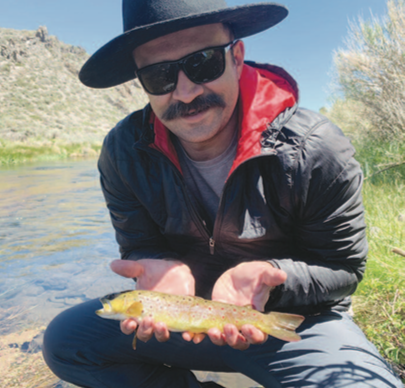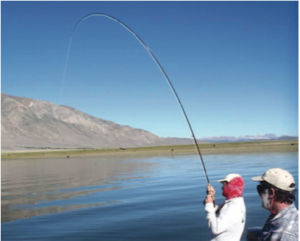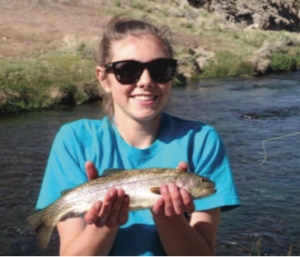
BY CHRIS LEONARD
MAMMOTH LAKES – If I had a dollar for every time that I’ve heard a first-time fly fisher tell me that they love casting flies at trout, I’d comfortably retire from guiding. I don’t know offhand how many first-time fly fishers I’ve instructed over the years, but it’s a lot. I get calls all the time from curious folks telling me that there’s something alluring and enticing about the world of fly fishing, and they want to give it a go. My objective over the course of a half- or full-day of guided instruction is to teach the basics, and infuse the desire to do it again. My batting average of effectively achieving both is pretty dang high. I know I have a client hooked when within less than two hours of time on the water, I’m asked, “So how much does a good fly rod cost?” Brings a smile to my face every time.
Fly fishing for trout in the Eastern Sierra is a hands-on experience. There is absolutely nothing wrong with soaking worms, or tossing lures, but most experienced anglers will agree that fly fishing means being much more a part of the process of hooking fish than “regular fishing” — a term I often hear first-time fly fishers use referring to bait fishing or spin fishing.
Most people don’t jump into fly fishing as their first time getting after trout. The majority of people who I’ve guided over the years have some background of fishing that they bring to the table. This could mean going after big game off the San Diego coastline, or fishing small creeks with a light spin rod. It is usually the case that anglers are looking for something more, some- thing different in chasing fish in the mountains while waving a fly rod around the air. I find myself teaching proper casting, which is different than casting with a spin rod. It takes some knowhow of the physics involved, but any good guide can teach someone how to do it.
Fly fishing for trout in the Eastern Sierra, simply put, is trying to fool fish with a decoy of their natural food source. Trout don’t regularly eat nightcrawlers or crickets. When they do, it usually means it’s their last supper. Trout are predator fish that will eat smaller bait- fish, but they also gorge on all sorts of aquatic bug life that is found in any river or lake where you find them. Without going too deep in the world of entomology, trout prefer a diet rich with caddis, mayflies, midges, stoneflies and whatever else they are served in a moving water system, or come across while cruising around in a lake. The task of a fly fisher targeting trout is the present to the unsuspecting fish a decoy of their natural food choice. You are showing trout an artificial imitation of a bug found in its hunting grounds, and if you do so correctly, you will probably feed that fish.
This is largely the lure of what brings people into the fly fishing world. I’ll give credit to the romanticism of fly fishing found in the Hollywood production, A River Runs Through It, but there is something about casting a fly rod that sparks curiosity. People who haven’t done it and are wondering about it are interested in why those of us who do, do so. Trout living in a moving water system are essentially looking at a conveyor belt of food constantly coming at them. Trout face upstream. This allows them to easily breathe by simply opening their mouths, allowing water to run through their gills. It also lets them pick and choose what’s for lunch and what’s not. For those of you who have sat at a Japanese restaurant that has the spinning conveyor belt of sushi on small colored plates that you pick off when you feel the desire to enjoy the meal, trout act the same way.

Trout will hunt down food. The scent of bait will attract the fish to the hook. However, under most circumstances, they lie in wait for the bugs to drift downstream to them. This is the job of the fly fisher, to keep the fly moving down this conveyor belt of food to present it to the trout to entice the fish to eat. It’s the heart and soul of the game. You do this by correctly casting your rod upstream and letting the bugs (your flies) drift past to the fish. There is a bit more to it than this, but that’s fly fishing for trout in a river system put into simple layman’s terms.
So why do it? Why not just soak worms or bait? Well, I think most people are drawn to fly fishing for trout in the Eastern Sierra because they like the idea of a different challenge. The challenge never ends. You don’t really ever master fly fishing to the point that you can hang up your hat and quit since you’ve caught every fish. Why not? This won’t happen. Some fish you will outsmart, and some fish will outsmart you. It’s a game. An incredibly enjoyable one. I also believe that fly fishing is more productive than pitching bait or lures. Since a fly rod is longer than a spin rod, used with a two-directional reel holding a much heavier line you can manipulate your fly easier with a fly rod than a bait or spin angler can with bait or lures. Casting is more precise. Drifts are better. Retrieves are more effective. I know more than one really skilled spin angler who will argue this against me. But I have no doubt that an experienced fly fisher will bag more fish on a river than an experienced spin fisher. You have the ability to better present your fly, and better control it in the water.
There’s also the thrill of the fight with a fly rod. While you’re going to present your bugs more naturally on the Upper Owens or Hot Creek with a fly rod, you’re also going to have a way more en- joyable fight on Crowley Lake or Bridgeport Reservoir when you watch that fly reel scream as the hooked fish peels off line until it decides to stop. A hooked trout is kind of a game of cat and mouse of seeing if you can tire out the fish before the fish spits the fly or breaks the knot. It’s always good practice to land a trout sooner rather than later to limit the amount of toxic lactic acid that it builds up during a fight, but the thrill of hooking a large fish on Crowley is incomparable to reel- ing one in that ate your worms on a spin rig. The fight can’t be described. It has to be experienced. Only then, will you know.

Fly fishing takes you to great places throughout the Eastern Sierra. While the vast majority of rivers and lakes that you can fly fish throughout the region also legally accommodate spin and bait anglers, fly fishers develop a certain curiosity of going after a pure-strain golden in the high country, or a wild brookie in a mountain creek. While there is a lot of angling pressure on the front range, there are millions of trout scattered throughout the backcountry in nearly almost every pond, lake and stream. It is a repose from the madness of society. Just you and the fish, surrounded by nature. Most first-time fly fishers find that casting flies is the best therapy you can find. You are thinking of nothing other than the cast you make, hoping this cast is the one to land the big one.
You’ve earned your fish when you caught it on a fly. While bait and spin anglers need to be able to read water to have a productive day, the challenge of a pre-senting a fly and hooking a fish with it is a step above tossing a bait-soaked treble hook into the pool. There is a certain gratification that comes with landing a fish that you tricked. It feels good. You did well. Trout can sense when something is off. And when you can get lucky and occasionally hook a fish while casting flies, under most circumstances it requires skill.
The Eastern Sierra is the perfect place to learn to fly fish. The creeks and rivers in the Eastern Sierra are much smaller than driftable waters like the Deschutes, Green or Madison. Most river and creek fishing in the Eastern Sierra are walk and wade trips. You’re not fishing big waters. They are also appropriate for tenkara fishing, which is fly fishing with a longer rod but no reel. This is another easy way to transition into fly fishing. There are also no shortage of great fly fisheries in the Eastern Sierra: The Owens River, Rock Creek, Rush Creek, East Walker River, West Walker River, Hot Creek, San Joaquin River, Crowley Lake, Bridgeport Reservoir, Virginia Lakes, Twin Lakes, Silver Lake… the list goes on and on. Trout are also the gateway drug… after chasing them for a while, you begin to wonder what it’s like to feed a tuna a fly, or land a smallmouth bass with a fly rod. You start small, but the world of fly fishing is infinite.
So, what’s the best way to learn? I believe that you need to go out with someone who can teach you the tricks. This may be a friend or family member. It may mean hiring a guide. Guides are instructors. Guides also understand their home waters. Even though I clearly understand fly fishing for trout, I hire guides on occasion when I’m fishing in unfamiliar waters because I want that immediate local knowledge. Trout that live in Hot Creek in California behave and feed quite different than trout that live in the South Platte River in Colorado. It’s a similar fish, but a different game. Local knowledge is always great to have on your side.
If you enjoy bait and spin fishing, and you are happy with it, more power to you. Do what works, and do what you love. If you want to learn to fly fish this summer, make a run to the Eastern Sierra, and you will see what you’ve been missing. It’s great fun and a whole new ballgame.
Chris Leonard (760-934-7566) guides for Kittredge Sports in Mammoth Lakes.



